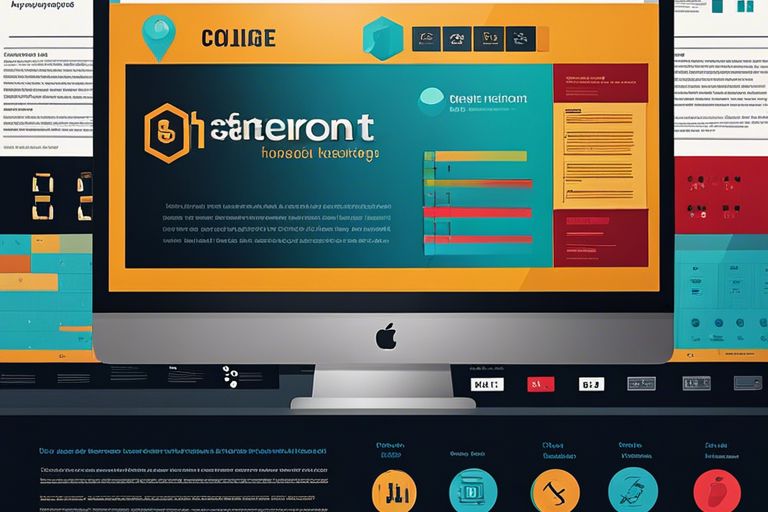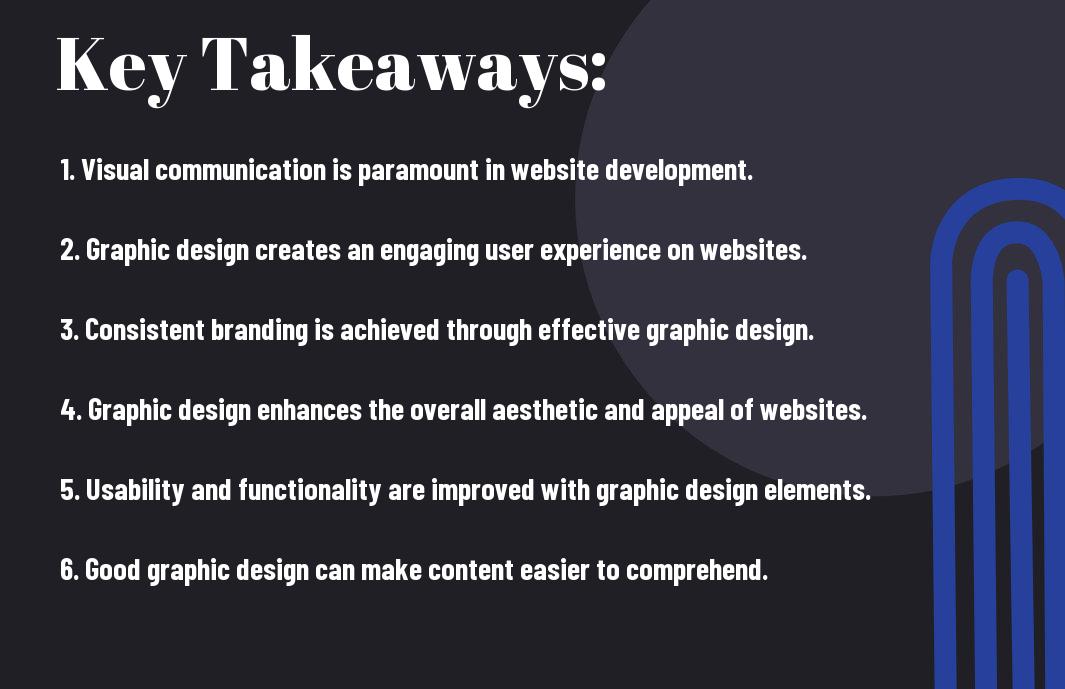Hello there! Have you ever wondered about the significant impact that graphic design has on website development? Well, wonder no more because in this blog post, we will delve into the essential role that graphic design plays in creating a visually appealing and user-friendly website. From enhancing the overall user experience to increasing brand recognition and engagement, the importance of graphic design in website development cannot be overstated. Whether you are a business owner looking to create a standout website or a web developer striving to optimize design, understanding the role of graphic design will be crucial to your success in the digital landscape. So, let’s dive in and explore the powerful impact of graphic design in website development.
Key Takeaways:
- Visual Impact: Graphic design plays a crucial role in creating a visually appealing and engaging website that captures the attention of visitors.
- User Experience: Effective graphic design enhances the user experience by organizing and presenting content in a way that is intuitive and easy to navigate.
- Branding and Identity: Graphic design helps to establish a strong brand identity and communicate the personality and values of a business through visual elements.
- Consistency: Consistent graphic design throughout a website helps to create a cohesive and professional look, reinforcing the brand image.
- Conversion Optimization: Well-designed graphics can lead to improved conversion rates by guiding users towards desired actions and creating a sense of trust and credibility.


Principles of Effective Graphic Design
Obviously, good graphic design is essential for creating a visually appealing and user-friendly website. There are several principles of effective graphic design that you should keep in mind when developing a website.
Visual Hierarchy and Layout
When designing a website, it’s crucial to consider the visual hierarchy and layout to guide the user’s attention and create a seamless user experience. You want to make sure that the most important elements on your website, such as your call-to-action buttons, stand out and are easily noticeable. Your visual hierarchy should lead the user’s eyes through the page in a natural and intuitive way, ensuring that they follow the path you’ve laid out for them.
Color Theory and Branding
Color theory plays a significant role in graphic design and branding. The colors you choose for your website should align with your brand’s identity and evoke the right emotions in your audience. Using the right color palette will help you create a strong and memorable brand identity, making your website visually appealing and recognizable.
Typography and Readability
Choosing the right fonts and ensuring readability is crucial for effective graphic design on a website. You should select fonts that are easy to read on all devices and screen sizes, and your typography should reflect your brand’s personality. Your typography choices can greatly impact the overall look and feel of your website, so it’s important to make the right decisions.
Responsiveness and Adaptability
With the increasing use of mobile devices, it’s essential that your website is responsive and adaptable to different screen sizes. You should ensure that your design looks great and functions well on all devices, providing a smooth experience for all users. Responsive design is no longer a luxury, it’s a necessity for any successful website.
Graphic Design Elements in User Experience (UX)
Despite the common misconception, graphic design plays a crucial role in shaping the user experience (UX) of a website. While web design focuses on the layout and functionality of a site, graphic design enhances the visual appeal and usability. In fact, the two are closely related but serve different purposes. You can learn more about the differences between graphic design and web design here.
The Impact of Imagery and Icons
When it comes to user experience, imagery and icons play a critical role in capturing your audience’s attention and conveying information effectively. The use of high-quality images and icons can significantly enhance the visual appeal of your website, making it more engaging and memorable for your visitors. Thoughtfully curated visuals can also help establish brand identity and create a more cohesive and immersive user experience for your audience.
Navigation and Interface Design
Your website’s navigation and interface design are essential components of the user experience. Intuitive navigation helps your visitors find what they’re looking for quickly and efficiently, improving their overall satisfaction with your site. Well-designed interfaces, including buttons, menus, and forms, contribute to a seamless and enjoyable browsing experience. By optimizing these elements, you can guide your users through your website, making it easier for them to engage with your content and take desired actions.
Incorporating Interactivity and Motion
Adding interactivity and motion to your website can have a significant impact on user engagement. Interactive elements such as animations, transitions, and hover effects can grab and hold your visitors’ attention, encouraging them to explore your site further. When used thoughtfully, these dynamic elements can bring your content to life and provide a more dynamic and immersive experience for your audience. However, it’s essential to strike the right balance, ensuring that these features enhance rather than detract from the user experience.
The Design Process in Website Development
Your website design process is a crucial part of website development. It plays a key role in creating a visually appealing and user-friendly website. To learn more about the design process, visit The Role of Graphic Web Design in Austin, Tx Website Development.
Research and Conceptualization
During the research and conceptualization phase, designers gather information about your business, target audience, and industry to gain a deep understanding of your brand. They create mood boards, color palettes, and initial designs to guide the visual direction of the website. This phase is crucial for creating a design that resonates with your audience and effectively represents your brand.
Wireframing and Prototyping
Wireframing and prototyping involve creating a skeletal framework and mockups of the website layout. This process allows you to visualize the structure of the site and its functionality. It helps identify potential issues in the early stages and provides a clear path for the design and development teams to follow. It ensures that the website’s layout and features are well thought out and intuitive for the end user.
Collaboration Between Designers and Developers
Collaboration between designers and developers is essential for a seamless design process. Designers and developers work together to ensure that the visual aspects and technical components of the website align. This close collaboration results in a well-designed, technically sound website that meets your business objectives and user needs.
Testing and Iteration
After the initial design is completed, the website undergoes thorough testing. This includes checking for usability, functionality, and compatibility across different devices and browsers. Any issues or areas for improvement are identified and addressed through iterations. Testing and iteration are crucial for delivering a high-quality website that provides a positive user experience.
Case Studies and Real-World Examples
To truly understand the impact of graphic design on website development, it’s crucial to examine real-world examples and case studies. Here are some successful examples:
- Company A saw a 43% increase in website traffic and a 25% increase in conversion rates after a graphic design overhaul.
- Company B reported a 200% increase in engagement on their website after implementing a new visual approach.
- With the help of a professional graphic designer, Company C experienced a $1 million increase in annual revenue due to a rebranding effort.
To read more about these case studies and other real-world examples, check out The Role of Graphic Design in Web Development – CC.
Success Stories of Effective Graphic Design
Effective graphic design can drastically improve the user experience and conversion rates on a website. By incorporating visually appealing elements and intuitive navigation, you can create a memorable and engaging online presence that resonates with your audience. By investing in professional graphic design, you can reinforce your brand identity and make a lasting impression on your visitors.
Analyzing Failures and Lessons Learned
On the flip side, neglecting the importance of graphic design in website development can lead to high bounce rates and missed conversion opportunities. Poorly designed websites can result in a lack of trust and credibility from visitors, ultimately impacting your bottom line. It’s crucial to carefully consider the visual aspects of your website and ensure that the design elements effectively communicate your brand message and value proposition.
Concluding Thoughts: The Role of Graphic Design in Website Development
On the whole, graphic design plays a crucial role in website development by enhancing the visual appeal, user experience, and overall branding of a website. By creating visually captivating layouts, choosing the right color schemes, and incorporating compelling imagery, you can effectively capture the attention of your audience and convey your brand’s identity. Additionally, the use of typography and other graphic elements can significantly impact the readability and navigability of your website. By understanding the importance of graphic design in website development, you can create a visually stunning and cohesive online presence that truly represents your brand and engages your audience.
FAQ: The Role of Graphic Design in Website Development
Q: What is the role of graphic design in website development?
A: Graphic design in website development is crucial for creating visually appealing and user-friendly websites. It involves the use of images, colors, typography, and layout to enhance the overall aesthetic and usability of a website.
Q: How does graphic design contribute to user experience in website development?
A: Graphic design plays a significant role in improving user experience by creating intuitive navigation, visually engaging content, and clear calls-to-action. It helps in guiding users through the website and ensuring a positive and memorable interaction.
Q: What are the key elements of graphic design in website development?
A: The key elements of graphic design in website development include visual hierarchy, color schemes, imagery selection, typography, and branding. These elements work together to convey the brand’s message and engage the audience effectively.
Q: How does graphic design impact branding and marketing on a website?
A: Graphic design establishes the visual identity of a brand on the website, creating a consistent and memorable brand image. It also plays a crucial role in marketing by creating visual content that captures the attention of users and communicates the brand’s message effectively.
Q: What are the benefits of incorporating strong graphic design in website development?
A: Strong graphic design in website development can lead to increased user engagement, improved brand recognition, higher conversion rates, and a positive overall impression of the brand. It also helps in setting a website apart from the competition and creating a unique and memorable online presence.
